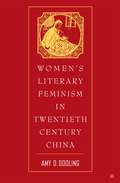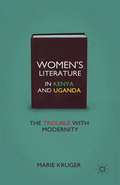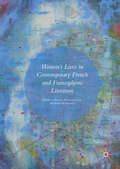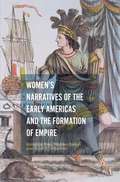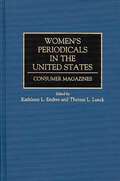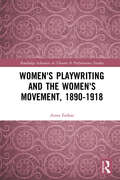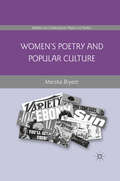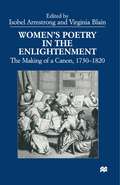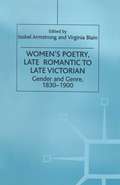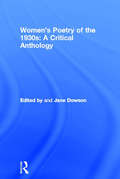- Table View
- List View
Women's Literacy in Early Modern Spain and the New World
by Rosilie HernándezContaining essays from leading and recent scholars in Peninsular and colonial studies, this volume offers entirely new research on women's acquisition and practice of literacy, on conventual literacy, and on the cultural representations of women's literacy. Together the essays reveal the surprisingly broad range of pedagogical methods and learning experiences undergone by early modern women in Spain and the New World. Focusing on the pedagogical experiences in Spain, New Spain (present-day Mexico), and New Granada (Colombia) of such well-known writers as Saint Teresa of à vila, Sor Juana Inés de la Cruz, and MarÃa de Zayas, as well as of lesser-known noble women and writers, and of nuns in the Spanish peninsula and the New World, the essays contribute significantly to the study of gendered literacy by investigating the ways in which women”religious and secular, aristocratic and plebeian”became familiarized with the written word, not only by means of the education received but through visual art, drama, and literary culture. Contributors to this collection explore the abundant writings by early modern women to disclose the extent of their participation in the culture of Spain and the New World. They investigate how women”playwrights, poets, novelists, and nuns” applied their education both to promote literature and to challenge the male-dominated hierarchy of church and state. Moreover, they shed light on how women whose writings were not considered literary also took part in the gendering of Hispanic culture through letters and autobiographies, among other means, and on how that same culture depicted women's education in the visual arts and the literature of the period.
Women's Literacy in Early Modern Spain and the New World
by Rosilie HernándezContaining essays from leading and recent scholars in Peninsular and colonial studies, this volume offers entirely new research on women's acquisition and practice of literacy, on conventual literacy, and on the cultural representations of women's literacy. Together the essays reveal the surprisingly broad range of pedagogical methods and learning experiences undergone by early modern women in Spain and the New World. Focusing on the pedagogical experiences in Spain, New Spain (present-day Mexico), and New Granada (Colombia) of such well-known writers as Saint Teresa of à vila, Sor Juana Inés de la Cruz, and MarÃa de Zayas, as well as of lesser-known noble women and writers, and of nuns in the Spanish peninsula and the New World, the essays contribute significantly to the study of gendered literacy by investigating the ways in which women”religious and secular, aristocratic and plebeian”became familiarized with the written word, not only by means of the education received but through visual art, drama, and literary culture. Contributors to this collection explore the abundant writings by early modern women to disclose the extent of their participation in the culture of Spain and the New World. They investigate how women”playwrights, poets, novelists, and nuns” applied their education both to promote literature and to challenge the male-dominated hierarchy of church and state. Moreover, they shed light on how women whose writings were not considered literary also took part in the gendering of Hispanic culture through letters and autobiographies, among other means, and on how that same culture depicted women's education in the visual arts and the literature of the period.
Women's Literary Collaboration, Queerness, and Late-Victorian Culture (The Nineteenth Century Series)
by Jill R. EhnennThe first full-length study to focus exclusively on nineteenth-century British women while examining queer authorship and culture, Jill R. Ehnenn's book is a timely interrogation into the different histories and functions of women's literary partnerships. For Vernon Lee (Violet Paget) and 'Kit' Anstruther-Thomson; Somerville and Ross (Edith Somerville and Violet Martin); Elizabeth Robins and Florence Bell; and Katharine Bradley and Edith Cooper, the couple who wrote under the pseudonym of 'Michael Field', collaborative life and work functioned strategically, as sites of discursive resistance that critique Victorian culture in ways that would be characterized today as feminist, lesbian, and queer. Ehnenn's project shows that collaborative texts from such diverse genres as poetry, fiction, drama, the essay, and autobiography negotiate many limitations of post-Enlightenment patriarchy: Cartesian subjectivity and solitary creativity, industrial capitalism and alienated labor, and heterosexism. In so doing, these jointly authored texts employ a transgressive aesthetic and invoke the potentials of female spectatorship, refusals of representation, and the rewriting of history. Ehnenn's book will be a valuable resource for scholars and students of Victorian literature and culture, women's and gender studies, and collaborative writing.
Women's Literary Collaboration, Queerness, and Late-Victorian Culture (The Nineteenth Century Series)
by Jill R. EhnennThe first full-length study to focus exclusively on nineteenth-century British women while examining queer authorship and culture, Jill R. Ehnenn's book is a timely interrogation into the different histories and functions of women's literary partnerships. For Vernon Lee (Violet Paget) and 'Kit' Anstruther-Thomson; Somerville and Ross (Edith Somerville and Violet Martin); Elizabeth Robins and Florence Bell; and Katharine Bradley and Edith Cooper, the couple who wrote under the pseudonym of 'Michael Field', collaborative life and work functioned strategically, as sites of discursive resistance that critique Victorian culture in ways that would be characterized today as feminist, lesbian, and queer. Ehnenn's project shows that collaborative texts from such diverse genres as poetry, fiction, drama, the essay, and autobiography negotiate many limitations of post-Enlightenment patriarchy: Cartesian subjectivity and solitary creativity, industrial capitalism and alienated labor, and heterosexism. In so doing, these jointly authored texts employ a transgressive aesthetic and invoke the potentials of female spectatorship, refusals of representation, and the rewriting of history. Ehnenn's book will be a valuable resource for scholars and students of Victorian literature and culture, women's and gender studies, and collaborative writing.
Women's Literary Creativity and the Female Body
by D. Hoeveler D. Decker Schuster Donna Decker SchusterThis volume addresses one aspect of a challenging topic: what does it mean for women to create within particular literary and cultural contexts? How is the female body written on textuality? In short, how is the female body analogous to the geographical space of land? How have women inhabited their bodies as people have lived in nation-states?
Women’s Literary Feminism in Twentieth-Century China
by A. DoolingThis is a critical inquiry into the connections between emergent feminist ideologies in China and the production of 'modern' women's writing from the demise of the last imperial dynasty to the founding of the PRC. It accentuates both well-known and under-represented literary voices who intervened in the gender debates of their generation as well as contextualises the strategies used in imagining alternative stories of female experience and potential. It asks two questions: first, how did the advent of enlightened views of gender relations and sexuality influence literary practices of 'new women' in terms of narrative forms and strategies, readership, and publication venues? Second, how do these representations attest to the way these female intellectuals engaged and expanded social and political concerns from the personal to the national?
Women's Literary Networks and Romanticism: "A Tribe of Authoresses" (Romantic Reconfigurations: Studies in Literature and Culture 1780-1850 #1)
by Andrew Winckles Angela RehbeinAn Open Access edition of this book is available on the Liverpool University Press website and through Knowledge Unlatched. The eighteenth century witnessed the rapid expansion of social, political, religious and literary networks in Great Britain. Increased availability of and access to print combined with the ease with which individuals could correspond across distance ensured that it was easier than ever before for writers to enter into the marketplace of ideas. However, we still lack a complex understanding of how literary networks functioned, what the term ‘network’ means in context, and how women writers in particular adopted and adapted to the creative possibilities of networks. This collection of essays address these issues from a variety of perspectives, arguing that networks not only provided women with access to the literary marketplace, but fundamentally altered how they related to each other, to their literary production, and to the broader social sphere. By examining the texts and networks of authors as diverse as Sally Wesley, Elizabeth Hamilton, Susanna Watts, Elizabeth Heyrick, Joanna Baillie, Mary Berry, Mary Russell Mitford, Mary Shelley and Elizabeth Barrett Browning, this volume demonstrates that attention to the scope and influence of women’s literary networks upends long standing assumptions about gender, literary influence and authorial formation during the Romantic period. Furthermore, it suggests that we must rethink what counts as literature in the Romantic period, how we read it, and how we draw the boundaries of Romanticism.
Women’s Literature in Kenya and Uganda: The Trouble with Modernity
by M. KrugerFor nearly a decade, writers' collectives such as Kwani Trust in Kenya and Femrite , the Ugandan women writers' association, have dramatically reshaped the East African literary scene. This text extends the purview of postcolonial literary studies by providing the long overdue critical inquiry that these writers so urgently deserve.
Women’s Lives in Contemporary French and Francophone Literature
by Florence Ramond Jurney Karen McPhersonThe essays in this volume provide an overview and critical account of prevalent trends and theoretical arguments informing current investigations into literary treatments of motherhood and aging. They explore how two key stages in women’s lives—maternity and old age—are narrated and defined in fictions and autobiographical writings by contemporary French and francophone women. Through close readings of Maryse Condé, Hélène Cixous, Zahia Rahmani, Linda Lê, Pierrette Fleutieux, and Michèle Sarde, among others, these essays examine related topics such as dispossession, female friendship, and women’s relationships with their mothers. By adopting a broad, synthetic approach to these two distinct and defining stages in women’s lives, this volume elucidates how these significant transitional moments set the stage for women’s evolving definitions (and interrogations) of their identities and roles.
Women's Lives Into Print: The Theory, Practice and Writing of Feminist Auto/Biography
by Pauline PolkeyWomen's Lives into Print provides a remarkable collection of essays by feminist scholars and writers who focus on the theory, practice and writing of women's auto/biographies. Not only does it foster debate about the reading and interpretation of women's lives, it also explores issues relating to research methodology, and raises questions about the representation of women within feminist auto/biography. Working across a range of subject disciplines, this book comprises a vital and ground-breaking critical text for anyone interested in auto/biography.
Women’s Manga in Asia and Beyond: Uniting Different Cultures and Identities (Palgrave Studies in Comics and Graphic Novels)
by Rebecca Suter John A. Lent Kazumi Nagaike Fusami OgiWomen’s Manga in Asia and Beyond offers a variety of perspectives on women’s manga and the nature, scope, and significance of the relationship between women and comics/manga, both globally as well as locally. Based on the activities since 2009 of the Women’s MANGA Research Project in Asia (WMRPA), the edited volume elucidates social and historical aspects of the Asian wave of manga from ever-broader perspectives of transnationalization and glocalization. With a specific focus on women’s direct roles in manga creation, it illustrates how the globalization of manga has united different cultures and identities, focusing on networks of women creators and readerships. Taking an Asian regional approach combined with investigations of non-Asian cultures which have felt manga’s impact, the book details manga’s shift to a global medium, developing, uniting, and involving increasing numbers of participants worldwide. Unveiling diverse Asian identities and showing ways to unite them, the contributors to this volume recognize the overlaps and unique trends that emerge as a result.
Women’s Movements in Post-“Arab Spring” North Africa (Comparative Feminist Studies)
by Fatima SadiqiCentering on women's movements before, during, and after the revolutions, Women's Movements in Post-"Arab Spring" North Africa highlights the broader sources of authority that affected the emergence of new feminist actors and agents and their impact on the sociopolitical landscapes of the region.
Women’s Narratives and the Postmemory of Displacement in Central and Eastern Europe (Palgrave Studies in Life Writing)
by Simona MitroiuThis volume explores the different mechanisms and forms of expression used by women to come to terms with the past, focusing on the variety and complexity of women’s narratives of displacement within the context of Central and Eastern Europe. The first part addresses the quest for personal (post)memory from the perspective of the second and third generations. The touching collaboration established in reconstructing individual and family (post)memories offers invaluable insights into the effects of displacement, coping mechanisms, and resilience. Adopting the idea that the text itself becomes a site of (post)memory, the second part of the volume brings into discussion different sites and develops further this topic in relation to the creative process and visual text. The last part questions the past in relation to trauma and identity displacement in the countries where abusive regimes destroyed social bonds and had a lasting impact on the people lives.
Women’s Narratives of the Early Americas and the Formation of Empire
by Mary McAleer Balkun Susan C. ImbarratoThe essays in this collection examine the connections between the forces of empire and women's lives in the early Americas, in particular the ways their narratives contributed to empire formation. Focusing on the female body as a site of contestation, the essays describe acts of bravery, subversion, and survival expressed in a variety of genres, including the saga, letter, diary, captivity narrative, travel narrative, verse, sentimental novel, and autobiography. The volume also speaks to a range of female experience, across the Americas and across time, from the Viking exploration to early nineteenth-century United States, challenging scholars to reflect on the implications of early American literature even to the present day.
Women's Negotiations and Textual Agency in Latin America, 1500-1799 (Women and Gender in the Early Modern World)
by Ma D젺 Quispe-Agnoli Roc쭼Even though women have been historically underrepresented in official histories and literary and artistic traditions, their voices and writings can be found in abundance in the many archives of the world where they remain to be uncovered. The present volume seeks to recover women’s voices and actions while studying the mechanisms through which they authorized themselves and participated in the creation of texts and documents found in archives of colonial Latin America. Organized according to three main themes, "Censorship and the Body," "Female Authority and Legal Discourse," and "Private Lives and Public Opinions," the essays in this collection focus on women’s knowledge and the discursive traces of their daily concerns found in various colonial genres. Herein we consider women not only as agents of history, but rather as authors of written records produced either by their own hand or by means of dictations, collaborations, or rewritings of their oral renditions. Inhabiting the territories of the Iberian colonies from Peru to New Spain, the women studied in this volume come from different ethnic and social backgrounds, from African slaves to the indigenous elite and to those who arrived from Iberia and were known as "Old Christians." Finally, we have prepared this volume in hopes that the readers will find a particular appeal in archival sources, in lesser-known documents, and in the processes involved in the circulation of knowledge and print culture between the 1500s and the late 1700s.
Women's Negotiations and Textual Agency in Latin America, 1500-1799 (Women and Gender in the Early Modern World)
by Mónica Díaz Rocío Quispe-AgnoliEven though women have been historically underrepresented in official histories and literary and artistic traditions, their voices and writings can be found in abundance in the many archives of the world where they remain to be uncovered. The present volume seeks to recover women’s voices and actions while studying the mechanisms through which they authorized themselves and participated in the creation of texts and documents found in archives of colonial Latin America. Organized according to three main themes, "Censorship and the Body," "Female Authority and Legal Discourse," and "Private Lives and Public Opinions," the essays in this collection focus on women’s knowledge and the discursive traces of their daily concerns found in various colonial genres. Herein we consider women not only as agents of history, but rather as authors of written records produced either by their own hand or by means of dictations, collaborations, or rewritings of their oral renditions. Inhabiting the territories of the Iberian colonies from Peru to New Spain, the women studied in this volume come from different ethnic and social backgrounds, from African slaves to the indigenous elite and to those who arrived from Iberia and were known as "Old Christians." Finally, we have prepared this volume in hopes that the readers will find a particular appeal in archival sources, in lesser-known documents, and in the processes involved in the circulation of knowledge and print culture between the 1500s and the late 1700s.
Women's Networks in Medieval France: Gender and Community in Montpellier, 1300-1350 (The New Middle Ages)
by Kathryn L. ReyersonThis book illuminates the connections and interaction among women and between women and men during the medieval period. To do this, Kathryn L. Reyerson focuses specifically on the experiences of Agnes de Bossones, widow of a changer of the mercantile elite of Montpellier. Agnes was a real estate mogul and a patron of philanthropic institutions that permitted lower strata women to survive and thrive in a mature urban economy of the period before 1350. Notably, Montpellier was a large urban center in southern France. Linkages stretched horizontally and vertically in this robust urban environment, mitigating the restrictions of patriarchy and the constraints of gender. Using the story of Agnes de Bossones as a vehicle to larger discussions about gender, this book highlights the undeniable impact that networks had on women’s mobility and navigation within a restrictive medieval society.
Women’s Orients: Sexuality, Religion and Work
by Billie MelmanIn this highly acclaimed study, Billie Melman recovers the unwritten history of the European experience of the Middle-East during the colonial era. She focuses on the evolution of Orientalism and the reconstruction - through contact with other cultures - of gender and class. Beginning with the eighteenth century Billie Melman describes the many ways in which women looked at oriental people and places and developed a discourse which presented a challenge to hegemonic notions on the exotic and 'different'. Through her examination of the writings of famous feminist writers, travellers, ethnographers, missionaries, archaeologists and Biblical scholars, many of which are studied here for the first time, Billie Melman challenges traditional interpretations of Orientalism, placing gender at the forefront of colonial studies. 'This book provides a real extension to Edward Said's writing not only in the sense of challenging Edward Said's perspective, but also by adding a significant empirical and conceptual element to the discussion on orientalism. Those interested in women's history, in the cultural politics of cross-cultural encounters and in feminist or cultural theory will find much to engage them, inform them and challenge them in Melman's book.' - Joanna De Groot, Times Higher Education Supplement 'Using the perspectives of both gender and class Melman sets an alternative view of the Orient against that of Said... a much less monolithic and much more complex and heterogenous than that of Said' - Francis Robinson, Times Literary Supplement 'Women's Orients is an important contribution to our understanding of Orientalism. Melman's work is characterized by a fruitful bringing together of the skills of the historian with the sensitive reading of the British women writers...' - Catherine Hall, The Feminist Review 'An excellent work... This book is a must for anyone interested in women's history, both English and Middle Eastern. It is well written and well argued and effectively does what it promises to do' - Afaf Lutfi Al-Sayyid Marsot, The International History Review 'Women's Orients, a project of recovery and analysis, is an important consideration of European women traveller's writing on the Middle East. It provides a rich and detailed interpretation of a feminine version of the Orient' - Sherifa Zuhur, MESA Bulletin 'The book raises provocative issues and suggests complexities that deepen our understanding of colonial changes and representations' - Dorothy O.Helly, American Historical Review.
Women's Periodicals in the United States: Consumer Magazines (Historical Guides to the World's Periodicals and Newspapers)
by Kathleen L. Endres Therese LueckConsumer magazines aimed at women are as diverse as the market they serve. Some are targeted to particular age groups, while others are marketed to different socioeconomic groups. These magazines are a reflection of the needs and interests of women and the place of women in American society. Changes in these magazines mirror the changing interests of women, the increased purchasing power of women, and the willingness of advertisers and publishers to reach a female audience.This reference book is a guide to women's consumer magazines published in the United States. Included are profiles of 75 magazines read chiefly by women. Each profile discusses the publication history and social context of the magazine and includes bibliographical references and a summary of publication statistics. Some of the magazines included started in the 19th century and are no longer published. Others have been available for more than a century, while some originated in the last decade. An introductory chapter discusses the history of U.S. consumer women's magazines, and a chronology charts their growth from 1784 to the present.
Women's Playwriting and the Women's Movement, 1890-1918 (Routledge Advances in Theatre & Performance Studies)
by Anna FarkasThe influence of the women’s movement has long been a scholarly priority in the study of British women’s drama of the late nineteenth and early twentieth centuries, but previous scholarship has largely clustered around two events: the New Woman in the 1890s and the suffrage campaign in the years before the First World War. Women’s Playwriting and the Women’s Movement, 1890–1918 is the first designated study of British women’s drama from a period of exceptional productivity and innovation for female playwrights. Both the British theatre and women’s position within British society underwent fundamental changes in this period, and this book shows how female dramatists carefully negotiated their position in the heated debates about women’s rights that occurred at this time, while staking out a place for themselves in an evolving theatrical landscape. Farkas also identifies the women’s movement as a key influence on the development of female-authored drama between 1890 and 1918, but argues that scholarly prioritizing of the "radicalism" of work associated with the New Woman and the suffrage campaign has had a distorting effect in the past. Ideal for scholars of British and Victorian theatre, Women’s Playwriting and the Women’s Movement, 1890–1918 offers a new perspective which emphasizes the complexity of women playwrights’ engagement with first-wave feminism and links it to the diversification of the British theatre in this period.
Women's Playwriting and the Women's Movement, 1890-1918 (Routledge Advances in Theatre & Performance Studies)
by Anna FarkasThe influence of the women’s movement has long been a scholarly priority in the study of British women’s drama of the late nineteenth and early twentieth centuries, but previous scholarship has largely clustered around two events: the New Woman in the 1890s and the suffrage campaign in the years before the First World War. Women’s Playwriting and the Women’s Movement, 1890–1918 is the first designated study of British women’s drama from a period of exceptional productivity and innovation for female playwrights. Both the British theatre and women’s position within British society underwent fundamental changes in this period, and this book shows how female dramatists carefully negotiated their position in the heated debates about women’s rights that occurred at this time, while staking out a place for themselves in an evolving theatrical landscape. Farkas also identifies the women’s movement as a key influence on the development of female-authored drama between 1890 and 1918, but argues that scholarly prioritizing of the "radicalism" of work associated with the New Woman and the suffrage campaign has had a distorting effect in the past. Ideal for scholars of British and Victorian theatre, Women’s Playwriting and the Women’s Movement, 1890–1918 offers a new perspective which emphasizes the complexity of women playwrights’ engagement with first-wave feminism and links it to the diversification of the British theatre in this period.
Women's Poetry and Popular Culture (Modern and Contemporary Poetry and Poetics)
by Marsha BryantBridging feminist and cultural studies, the book shows how British and American women poets often operate as cultural insiders. Individual chapters reassess major figures (H.D., Gwendolyn Brooks, Sylvia Plath), alternative modernist poets (Edith Sitwell, Stevie Smith), and contemporary poets (Ai, Carol Ann Duffy).
Women’s Poetry in the Enlightenment: The Making of a Canon, 1730–1820
by Isobel Armstrong Virginia BlainThis collection of twelve critical essays on women's poetry of the eighteenth century and enlightenment is the first to range widely over individual poets and to undertake a comprehensive exploration of their work. Experiment with genre and form, the poetics of the body, the politics of gender, revolutionary critique, and patronage, are themes of the collection, which includes discussions of the distinctive projects of Mary Leapor, Ann Yearsley, Helen Maria Williams, Joanna Baillie, Charlotte Smith, Anna Barbauld and Lucy Aikin.
Women’s Poetry, Late Romantic to Late Victorian: Gender and Genre, 1830–1900
by I. Armstrong V. BlainThe first collection to make a comprehensive study of nineteenth-century women's poetry from late Romantic to late Victorian 'new woman' writers. Eighteen essays consider the gendered codes and genres developed by sophisticated poets. The feminine subject and marketing, a woman's tradition, lesbian desire, war, race, colonial experience, religion and science are themes of the collection, featuring, as well as the familiar Christina Rossetti and Elizabeth Barrett Browning, other poets such as 'L.E.L.', Felicia Hemans, Amy Levy and Augusta Webster.
Women's Poetry of the 1930s: A Critical Anthology
by Jane DowsonWhere were the women of the so-called `Auden Generation'?During this era of rapidly changing gender roles,social values and world politics,women produced a rich variety of poetry.But until now their work has largely been lost or ignored;in Women's Poetry of the 1930s Jane Dowson finally redresses the balance and recovers women's place in the literary history of the interwar years.This comprehensive and beautifully edited collection includes: *Previously uncollected poems by authors such as Winifred Holtby and Naomi Mitchison *Poems which are now out of print,such as those by Vita Sackville-West and Frances Cornford *Poems previously neglected by poets including Ann Ridler and Sylvia Townsend Warner *An extensive critical introduction and individual biographies of each poet Poetry lovers,students and scholars alike will find Women's Poetry of the 1930s an invaluable resource and a collection to treasure.



